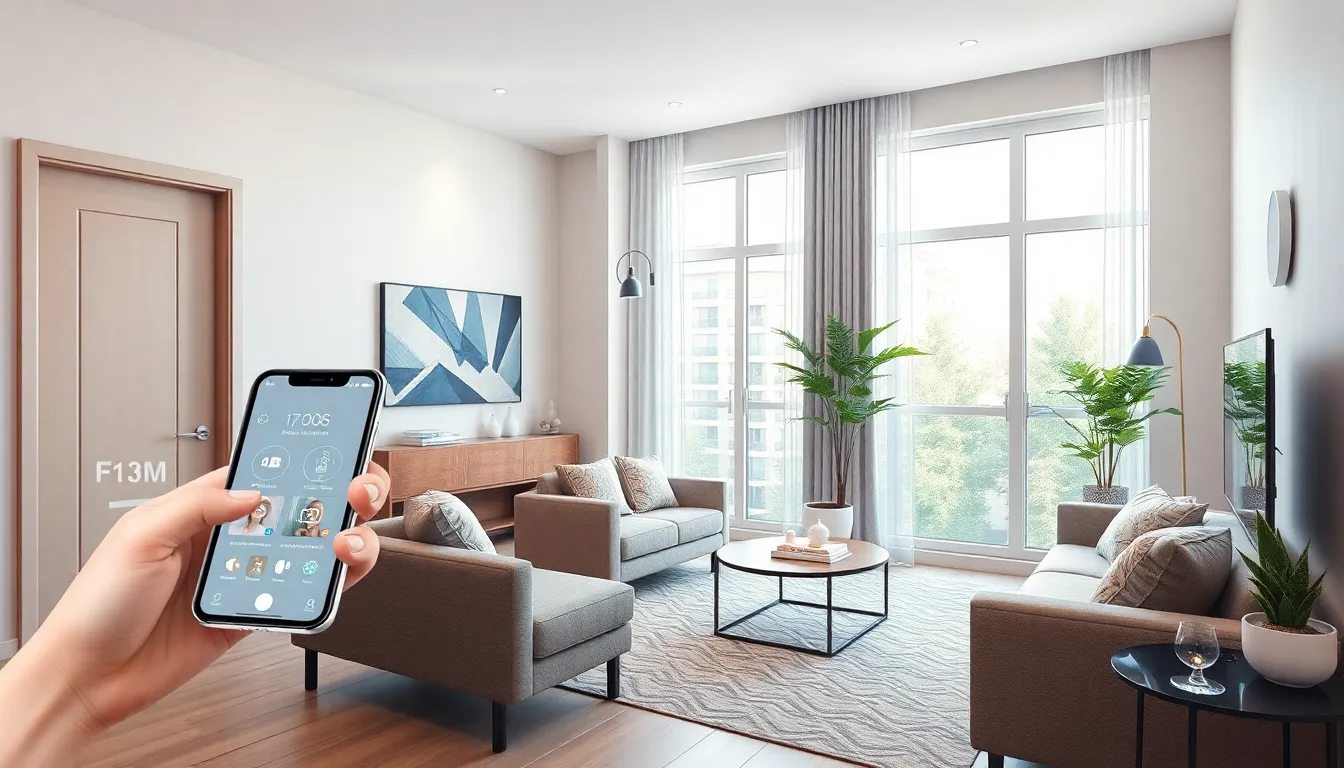Table of Contents
ToggleIn a world where even your toaster can be smarter than your average houseplant, smart home technology is revolutionizing apartment living. Gone are the days of fumbling for light switches or wondering if you left the oven on. With just a few taps on a smartphone, residents can control everything from the temperature to their morning coffee—because who has time to brew it manually?
Overview Of Smart Home Technology For Apartments
Smart home technology enhances apartment living by integrating various devices for more efficient daily operations. Many apartment residents benefit from voice-controlled systems that manage everything from lighting to thermostats. These systems allow users to adjust settings remotely and tailor their environment to personal preferences.
Devices designed specifically for apartment living include smart locks, cameras, and sensors. Smart locks provide keyless entry, increasing security while simplifying access for guests. Cameras enhance safety by offering video surveillance, allowing residents to monitor their apartments in real-time.
Thermostats within smart systems optimize energy usage. They learn user behaviors and adjust heating and cooling accordingly, which lowers energy bills. Smart plugs and outlets offer convenience by enabling control of smaller devices, such as lamps or coffee makers, from a smartphone, reducing the need for manual operation.
Interconnected lighting systems transform ambiance effortlessly. Users can program lighting scenes for various activities like movie nights or dinner parties with a few taps on an app. Additionally, smart speakers act as central hubs for controlling multiple devices with voice commands, streamlining the experience further.
Maintenance reminders also improve convenience in smart apartments. Devices can send notifications when filters need changing or when appliances require servicing. This proactive approach helps prolong the lifespan of appliances and system components.
Energy management and security become accessible with smart home technology. Apartment residents can monitor energy consumption via apps, leading to better management of resources. Enhanced security features offer peace of mind, making smart technology an essential component in modern apartment living.
Benefits Of Smart Home Technology

Smart home technology significantly enhances apartment living by providing numerous advantages. It streamlines daily routines, maximizes safety, and optimizes energy consumption.
Increased Convenience
Convenience stands out as a primary benefit of smart home technology. Residents can control lighting, appliances, and climate from their smartphones. Smart devices support automation for regular tasks like adjusting thermostats before arriving home. Voice commands simplify operations, allowing users to manage multiple functions hands-free. Smart locks offer keyless entry, eliminating the need to fumble for keys. Additionally, reminders prompt residents about needed actions, such as watering plants or taking out the trash. Smart home solutions ultimately foster an effortless lifestyle.
Enhanced Security
Enhanced security is another critical aspect of smart home technology. Smart locks provide secure access to apartments without traditional keys. Residents can monitor real-time camera feeds directly from their smartphones. Motion sensors alert users to unusual activity, ensuring peace of mind. Security systems can send alerts to phones, allowing for instantaneous response. Access logs track who enters or leaves, adding an extra layer of safety. Smart home technology equips residents with tools to protect their spaces effectively.
Energy Efficiency
Energy efficiency benefits from integrating smart home technology into apartments. Smart thermostats adjust heating and cooling based on residents’ schedules, significantly reducing energy waste. Programmable devices allow users to set energy-saving modes, further lowering costs. Smart plugs enable remote control of appliances, preventing unnecessary power usage. These devices can be scheduled to operate during off-peak hours, maximizing savings. Utilizing smart technology leads to lower energy bills and a reduced carbon footprint, making it an eco-friendly choice for modern living.
Popular Smart Home Devices For Apartments
Smart home devices enhance apartment living by simplifying daily tasks and increasing efficiency. Below are popular categories of smart home technology that make a significant impact.
Smart Lighting Solutions
Smart lighting solutions provide ultimate control over ambiance and energy usage. Users can adjust brightness and color with their smartphones or voice commands, creating different atmospheres for various occasions. Many systems support schedules, so lights automatically turn on and off based on user routines. Integration with other smart devices enables automation, such as dimming when a movie starts. Energy savings come from options like motion sensors that ensure lights operate only when needed.
Smart Thermostats
Smart thermostats optimize temperature settings based on individual habits, promoting energy efficiency in apartments. Programmable features allow users to set specific temperature preferences throughout the day. Many models learn user behaviors, automatically adjusting for comfort while minimizing energy usage. Remote access enables adjustments even when away from home, promoting both convenience and savings. Alerts about temperature fluctuations help maintain consistent heating and cooling, enhancing overall comfort.
Home Security Systems
Home security systems provide peace of mind for apartment residents, combining technology and convenience. Smart locks offer keyless entry and remote access, allowing users to lock or unlock doors from anywhere. Security cameras equipped with real-time monitoring capabilities ensure residents can check on their homes at any time. Many systems feature motion detection alerts, notifying users of any unusual activity. Integration with other smart devices allows for a comprehensive security network that protects and monitors the living space.
Integrating Smart Home Technology
Integrating smart home technology into an apartment enhances convenience and efficiency. Individuals can easily manage multiple devices for a streamlined living experience.
Choosing The Right Devices
Selecting appropriate devices for an apartment involves understanding specific needs. Smart lighting options like LED bulbs enable users to adjust brightness and color easily. Security cameras provide real-time surveillance without cumbersome equipment. Thermostats optimize energy use, tailoring settings to habits. Home assistants, such as smart speakers, coordinate various devices with simple voice commands. Selecting from these categories ensures that technology aligns with daily routines, maximizing both functionality and comfort.
Installation Tips For Renters
Installation of smart home devices in rentals requires careful consideration. Devices that require no permanent alterations are ideal, such as smart plugs and wireless cameras. Command strips or adhesive mounts can secure temporary installations without damaging walls. Utilizing a central hub simplifies connectivity, ensuring all devices communicate efficiently. Furthermore, checking the landlord’s policies before installing devices helps avoid potential conflicts. Following these tips promotes a seamless integration of technology while maintaining the rental’s integrity.
Challenges And Considerations
Smart home technology presents unique challenges for apartment living. Understanding these challenges ensures optimal use of devices tailored to renters’ needs.
Compatibility Issues
Compatibility poses significant concerns. Not all devices work seamlessly together, leading to potential frustrations. Operating systems from various manufacturers differ, creating limitations on integration. Residents may encounter obstacles when adding new technology to existing setups. For example, smart bulbs from one brand might not communicate with a central hub from another. Additionally, specific features may not function correctly across devices, impacting the user experience. Researching compatibility before investing in devices helps avoid these pitfalls.
Cost vs. Value
Cost versus value is a crucial consideration. Initial expenses for smart home devices can add up quickly, especially when outfitting an entire apartment. Prices vary significantly based on brand and functionality, with premium options often promising enhanced features. However, renters should weigh long-term savings against upfront costs. Energy-efficient devices, such as smart thermostats, contribute to lower utility bills over time. Similarly, enhanced security features can prevent costly break-ins, offering peace of mind. Evaluating each device’s return on investment aids in making informed purchasing decisions.
Smart home technology is transforming apartment living by providing unparalleled convenience and efficiency. With a range of devices available renters can automate daily tasks and enhance their living spaces effortlessly. These innovations not only streamline routines but also improve security and energy management.
As renters explore smart home options they should consider compatibility and cost-effectiveness. Investing in the right devices can lead to significant long-term savings and a more comfortable lifestyle. Embracing smart technology is a step toward a modern and eco-friendly home that meets the demands of today’s urban living.





